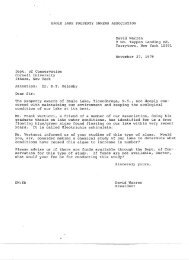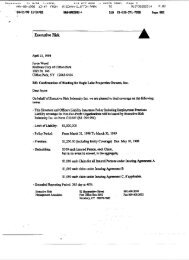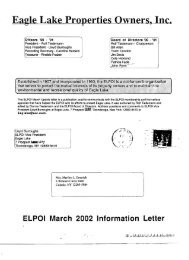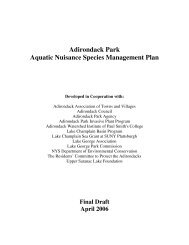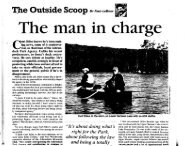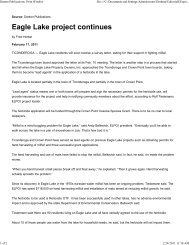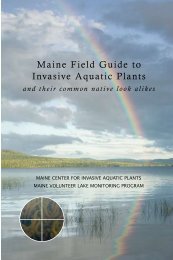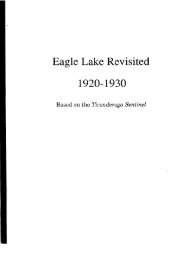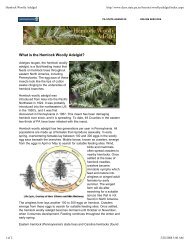SEIS - Eagle Lake Property Owner's Inc.
SEIS - Eagle Lake Property Owner's Inc.
SEIS - Eagle Lake Property Owner's Inc.
Create successful ePaper yourself
Turn your PDF publications into a flip-book with our unique Google optimized e-Paper software.
containment areas. The use of dredging as a primary management tool over the range of milfoilsites known for this lake is very limited on technical and financial grounds.Dyes and Surface CoversDyes are used to limit light penetration and therefore restrict the depth at which rooted plants cangrow. They tend to reduce the maximum depth of plant growth, but have little effect in shallowwater «4 ft deep). They are only selective in the sense that they favor species tolerant of lowlight or with sufficient food reserves to support an extended growth period (during which a stemcould reach the lighted zone). In lakes with high transparency but only moderate depth andample soft sediment accumulations, dyes may provide open water where little would otherwiseexist. Repeated treatment will be necessary, as the dye flushes out of the system. Dyes aretypically permitted under the same process as herbicides, despite their radically different mode ofaction.Surface shading has received little attention as a rooted plant control technique, probably as afunction of potential interference with recreational pursuits which are a goal of most rooted plantcontrol programs. Polyethylene sheets, floated on the lake surface, were used by Mayhew andRunkel (1962) to shade weeds. They found that two to three weeks of cover were sufficient toeliminate all species of pond weeds (Potamogeton spp.) for the summer if the sheets were appliedin spring before plants grew to maturity. Coontail was also controlled, but the generally desirablemacro alga Chara was not. This procedure should be a useful and inexpensive alternative totraditional methods of weed control in small areas such as docks and beaches, and could be timedto yield results acceptable to summer human users with minimal negative impacts to systemecology.Although dyes and/or surface covers might reduce milfoil growth in <strong>Eagle</strong> <strong>Lake</strong>, they would beexpected to impact the native pondweeds more, opening large areas for milfoil colonization at alater date. Although dyes are not especially expensive per unit area or volume treated, treatmentof the whole lake would be necessary on a repeated basis. The color, although not unpleasant, isartificial and would be recognized as such by most <strong>Eagle</strong> <strong>Lake</strong> enthusiasts. This technique is notconsidered appropriate for use at <strong>Eagle</strong> L~e.The use of surface covers over large areas would be logistically difficult in <strong>Eagle</strong> <strong>Lake</strong>, andwould be expected to impede boat traffic. The potential for movement by wind and damage byboats limits the probability of success for surface covers in <strong>Eagle</strong> <strong>Lake</strong> on any scale larger thanthat on which benthic barriers are now used. The use of surface covers for control of currentmilfoil growths in <strong>Eagle</strong> <strong>Lake</strong> is therefore deemed impractical.Mechanical RemovalThere are many variations on mechanical removal of macrophytes. Table 1 breaks these variedtechniques into hand pulling, cutting without collection, harvesting with collection, rototilling,and hydroraking. Suction dredging, addressed in the dredging section, could also be includedhere, as it is primarily intended to remove plant biomass. Other classification systems areD<strong>SEIS</strong> for <strong>Eagle</strong> <strong>Lake</strong> 36 ENSR



